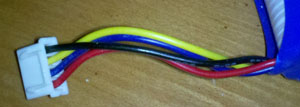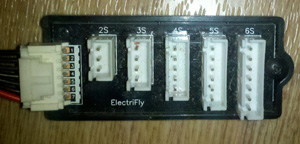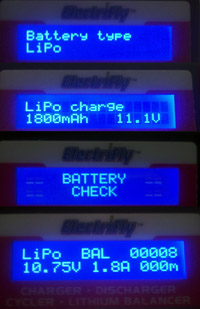LiPo Battery Charging
There's no question that LiPo battery charging done properly will increase the life and performance of your battery packs tremendously. But more importantly, you will drastically decrease the chances of a fire.

Tons of electronic devices use lithium batteries these days. Smart phones, cameras, flashlights, you name it. LiPo's are everywhere.If LiPo battery charging is so dangerous, why don't we hear of any fires or explosions with these devices?
The answer is simple. Each of these devices come with chargers specifically designed to charge the battery that comes with that particular device.
That's not the case in our hobby. The chargers we use have different settings for different size batteries. This makes it possible for the user to choose the wrong settings on the charger which can lead to fires.
Or even worse, people who don't know any better can easily make the mistake of using a charger that's not even made for LiPo's!
What is LiPo Balancing?
In addition to the main plug for powering the airplane, you'll notice that most all LiPo packs have a balancing plug like the one in the picture. This plug allows a balancing charger to monitor the voltage of each individual cell of the pack during LiPo battery charging.

From our discussion on LiPo Battery Packs, you know that lithium polymer cells must stay between 3.0V and 4.2V for optimal performance.
Some times the individual LiPo cells in a pack become unbalanced when being charged or discharge. For example, one cell may have a voltage of 3.8V while the rest are at 4.2V.
A LiPo balancer monitors and controls how much each cell in the LiPo pack is charged or discharged. This is a very important part of LiPo battery charging because balancing the pack will allow for the fullest possible safe voltage which results in more power while in flight.
A balanced pack also tends to last longer as no individual LiPo cells become over charged.
Most decent "smart chargers" will balance your LiPo batteries. If you happen to have an old charger without balancing capabilities, you can buy an external balancer that goes between your charger and battery pack.
LiPo Battery Chargers
Lithium polymer chargers use a different charging algorithm than any other type of battery charger. For this reason, a lithium polymer charger must be used when charging your LiPo battery pack.
Using a charger that is not specifically designed for LiPo batteries will damage the battery and could very easily catch fire.
Simple LiPo Chargers
Ready to Fly and Bind N Fly airplanes will most always come with a "simple" balancing charger that plugs right into the cigarette lighter of your vehicle.

If the charger is made for a 4s battery, then it will come with alligator clips for hooking straight to your car's battery in order to handle the larger amount of current.
In case you're wondering, 4s means the battery has four cells wired in series. You can lean more about LiPo battery sizes here.
You'll notice in the picture to the right that there is a switch and a dial. The switch selects between a 2s or 3s pack. The dial controls the charging current. I will explain how to set a safe charging current a little further down the page.
As you can see, the main plug of the battery is not used with this type of charger. All of the charging is done through the balancing plug. As you will see in a second, this is not the case with higher end "smart chargers".

Most of the Ultra Micro type airplanes and helis use a tiny one cell LiPo battery that requires a special charger.
Since they come with all Bind and Fly planes, these little chargers are beginning to take over my garage!
The four port charger seen to the right is what came with my Ultra Micro Helicopter, which is nice for charging several batteries at once. Many Ultra Micro planes come with similar chargers that only charge one battery at a time.
There are no switches or dials with these chargers. All you have to do is plug the battery in and wait. They are more or less "idiot proof". In other words, someone who knows absolutely nothing about LiPo battery charging won't be able to screw it up.

My Ultra Micro Extreme Beast uses single cell LiPo that is a bit larger than the single cell LiPo's used with my other ultra micros. It came with the charger seen in the picture to the right.
This one is "idiot proof" as well. All you have to do is plug the battery in and push the button to start the charge.
Smart LiPo Chargers
The chargers above are simple, cheap, and make LiPo battery charging easy. But they don't do the greatest job at balancing a LiPo pack.

A "smart" charger does a much better job of balancing the pack and charging them to their full potential which increases the performance and life of the battery.
When I say "smart" charger I am talking about the chargers that basically have built in computers. They make LiPo battery charging very easy to do in a safe manner.
The picture to the right is my Triton battery charger. Unlike the simple chargers above, it actually uses the main plug in addition to the balancing harness for charger.
Larger packs can be charged more quickly because higher current can flow through the larger gauge plug wire. The balancing ports are used to balance the cells once the battery nears full charge.

The balancing leads of the LiPo pack are plugged into a "charging harness". As you can see in the picture, it has different size receptacles for different size packs. The harness is plugged into the balancing port on the charger.
Since most "smart" chargers have the capability to charge any type of battery, you'll have to use the on screen menu to tell the charger that you're charging a LiPo battery.
Then you enter the voltage and capacity of your pack and the charger does the rest for you. Piece of cake!
What I really like about mine (and most all smart chargers have this ability) is that I can monitor the voltage of each cell so that I know for sure that the pack is balanced.

Once you have decided that flying RC airplanes is a hobby that you plan to stick with, I highly recommend investing in a "smart" charger of some sort for all of your LiPo battery charging needs.
If you're just getting started, you can get away with the simple balancing chargers that come with most beginner planes. As a matter of fact, that's all I used for the first couple of electric RC airplanes I had.
When I started using my Triton Smart charger I noticed that the generic chargers that came with the BNF planes did a pretty lousy job of balancing the packs. Of course I had no way of knowing this until I had my new charger that showed the voltage of each cell.
I still use the generic charger when I have several packs to charge at once. I just make sure to put all of the batteries into the Triton for a quick balance before flying.
LiPo Battery Charging Procedure
Lithium polymer battery packs do not develop a "memory" as NiCd batteries do. In other words, you don't have to worry about fully discharging LiPo battery packs before recharging them.
Your RC LiPo battery will be especially hot immediately after a flight. Always wait until the battery has reached ambient temperature before charging.
Current and voltage are the two variables that must be determined when charging LiPo batteries. The voltage should be set to the nominal voltage of the LiPo battery pack. For example, a 5000mAh 11.1V LiPo battery pack would be charged at 11.1V.

The current should never exceed a 1C charge rate during LiPo battery charging. For example, a 1800mAh 11.1V pack should be charged at 1.8 Amps or less. If you have the time, it's always better for the battery to charge at the lowest rate possible. But NEVER exceed 1C.
If you're using the charger that came with your BNF or RTF airplane, you would simply rotate the voltage dial to 1.8 Amps and move the selector switch to the three cell setting as seen in the picture.

On my Triton charger I would simply choose "LiPo" as the battery type. Select "1800" as the capacity and 11.1 as the voltage of the pack being charged.
I hold the selector knob in and the charge does a "check" to make sure the information I entered matches up with the voltage it measures from the battery. Then the LiPo battery charging begins.
This particular LiPo charger has a nice little display showing the voltage of the pack, the charging current, and how long the pack has been charging.
I can also scroll through and show the voltage of each cell along with a few other screens.
Triton also makes a temperature probe that I can put on the battery and the temperature of the pack will show on the screen. I could also program the charger to shut down if the temperature of the pack gets too high.
There are tons of good LiPo battery chargers on the market. It just so happened that when I was shopping for a charger my local hobby stores had this Triton charger on sale for a good price. I would recommend it to anyone as it's always worked great with no problems.
It's a simple fact that LiPo battery charging takes a while. Most of my batteries take 45 minutes to an hour to charge safely. The larger the capacity of the battery, the longer it takes to charge. This is why I have 2 or 3 batteries for all of my electric RC airplanes.
Learn More About LiPo Battery Packs Below...
Let’s Go Flying! |
|
5 Steps for Successful First Flight! When the RC bug bites, it bites hard! Control yourself my friend! Save yourself much time and money by following these five steps to success! |




